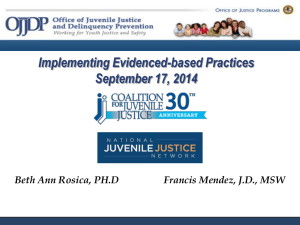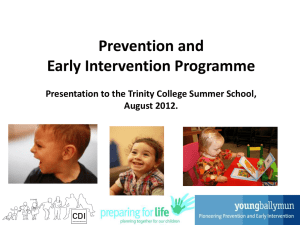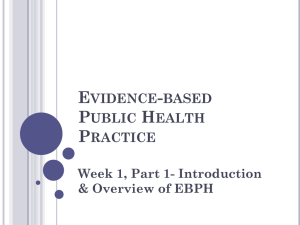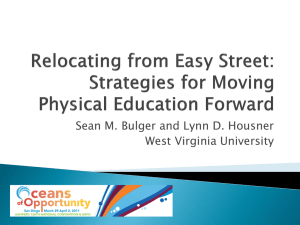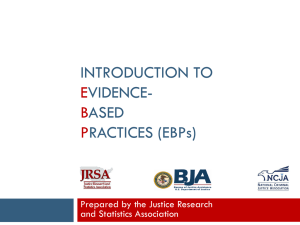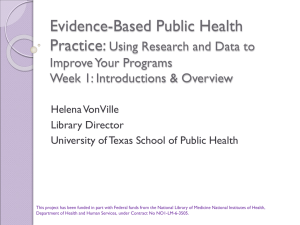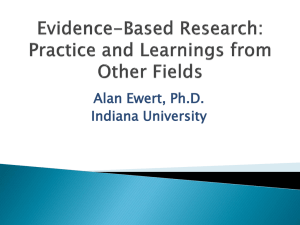Sharing Knowledge, Improving Lives
advertisement
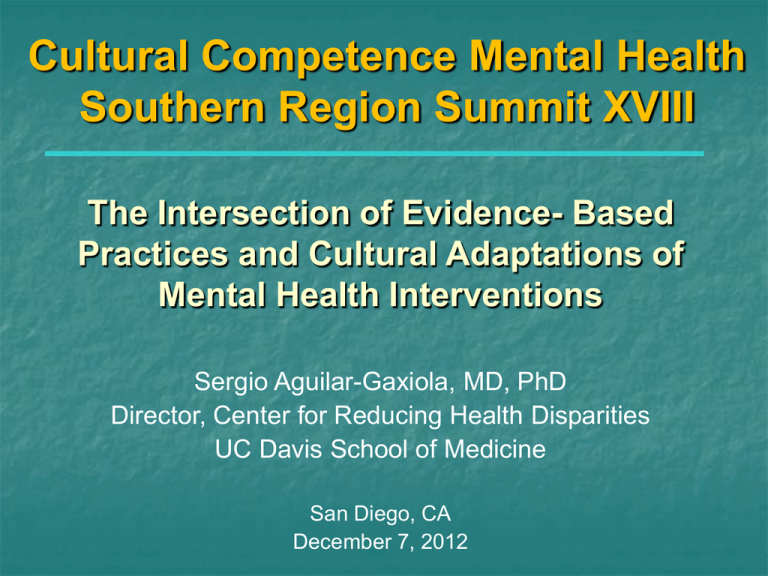
Cultural Competence Mental Health Southern Region Summit XVIII The Intersection of Evidence- Based Practices and Cultural Adaptations of Mental Health Interventions Sergio Aguilar-Gaxiola, MD, PhD Director, Center for Reducing Health Disparities UC Davis School of Medicine San Diego, CA December 7, 2012 Overview Types of practices Definitions of Evidence-Base Practices (EBPs) Types of studies and levels of evidence Who is represented in EBPs and key concerns Cultural adaptations of EBTs EBTs vs. Practice-based Evidence vs. Community-defined Evidence Recommendations “Strength is in our culture, but let us show you our success, not use your measurements of success…” “We are developing our own workforce, but not getting recognition because you use your measurements to measure us…” “We can’t only treat children, we have to treat the whole family” NA Community Leader “There is a way you talk to people in our communities…You have to know how to talk to black people.” Dr. Vanessa Siddle Walker, 2010 Source: Kindly Provided by Forrest Toms, 2010. 4 Ways of Knowing Clearly, there are differences in ways of knowing among cultures. What counts as “evidence” is defined differently from group to group. There is a cultural gap between a “scientific way of knowing” and clinicians’ professional ways of knowing There is an even wider gap between “scientific ways of knowing” and community, cultural ways of knowing. Source: Blasé & Fixsen, 2003, National Implementation Research Network, Louie de la Parte Florida Mental Health Institute, Consensus Statement on Evidence-Based Programs and Cultural Competence. How Communities Perceive Research Centers… How Communities Perceive Scientists… Evidence? What do we mean by “the best evidence available?” What are the dangers/advantages of focusing so much on outcomes? How does the debate and dialogue about “evidence” interact with issues of culture, race, and ethnicity? In what ways do you consider culture, race and ethnicity, sexual orientation when assessing the fit between an evidence-based program and a potential implementation site? Source: Blasé & Fixsen, 2003, National Implementation Research Network, Louie de la Parte Florida Mental Health Institute, Consensus Statement on Evidence-Based Programs and Cultural Competence. Three Types of Practices 1. Research Validated Best Practice 2. Field Tested Best Practice 3. Promising Practice Source: Compassion Capital Fund National Resource Center, Identifying and Promoting Promising Practices http://www.acf.hhs.gov/programs/ocs/ccf/about_ccf/gbk_pdf/pp_gbk.pdf. Three Types of Practices 1. Research Validated Best Practice A program, activity or strategy that has the highest degree of proven effectiveness supported by objective and comprehensive research and evaluation. Source: Compassion Capital Fund National Resource Center, Identifying and Promoting Promising Practices http://www.acf.hhs.gov/programs/ocs/ccf/about_ccf/gbk_pdf/pp_gbk.pdf. Three Types of Practices 2. Field Tested Best Practice A program, activity or strategy that has been shown to work effectively and produce successful outcomes and is supported to some degree by subjective and objective data sources. Source: Compassion Capital Fund National Resource Center, Identifying and Promoting Promising Practices http://www.acf.hhs.gov/programs/ocs/ccf/about_ccf/gbk_pdf/pp_gbk.pdf. Three Types of Practices 3. Promising Practice A program, activity or strategy that has worked within one organization and shows promise during its early stages for becoming a best practice with long term sustainable impact. A promising practice must have some objective basis for claiming effectiveness and must have the potential for replication among other organizations. Source: Compassion Capital Fund National Resource Center, Identifying and Promoting Promising Practices http://www.acf.hhs.gov/programs/ocs/ccf/about_ccf/gbk_pdf/pp_gbk.pdf. What is Evidence-Based Practice? “…interventions for which there is scientific evidence consistently showing that they improve client outcomes.” Source: Drake et al., 2001 “The integration of the best available research with clinical expertise in the context of patient characteristics, culture, and preferences.” Source: APA Presidential Task Force on EBPinP, 2005 Types of Studies “Efficacy Studies” Gold Standard scientifically to show if a drug or intervention works for a particular narrowly defined problem in carefully controlled populations and conditions. Randomized Controlled Clinical Trial “Effectiveness Studies” Less scientific power, but more socially relevant. What happens when the drug or intervention is used in the general population under ordinary care conditions. Follow-up studies Levels of Evidence Efficacious -- achieves child/family outcomes, based on controlled research (random assignment), with independent replication in controlled settings Effective -- achieves consumer outcomes, based on controlled research (random assignment), with independent replication in usual care settings Not effective -- significant evidence of a negative or harmful effect Promising -- some positive research evidence, quasiexperimental, of success and/or expert consensus Emerging -- recognizable as a distinct practice with “face” validity or common sense test Source: Carter, 2005 What are Promising Practices? “A ‘promising model’ is defined as one with at least preliminary evidence of effectiveness in small-scale interventions or for which there is potential for generating data that will be useful for making decisions about taking the intervention to scale and generalizing the results to diverse populations and settings.” Source: Department of Health and Human Services Administration for Children and Families Program Announcement. Federal Register, Vol. 68, No. 131, (July 2003), p. 40974 What is Community-Defined Evidence “A set of practices that communities have used and determined to yield positive results as determined by community consensus over time and which may or may not have been measured empirically but have reached a level of acceptance by the community.” Source: CDEP Working Group, 2007) Status of EBTs Little research related to evidence-based programs has been conducted with diverse, underserved populations. Most EBTs are conducted with white, educated, verbal, and middle class patients and may not generalize to ethnic minority communities. This makes it difficult to ascertain whether currently identified evidence-based programs are, in fact, best practices models for specific racial, ethnic, and cultural communities. Source: Blasé & Fixsen, 2004; Bernal & Scharrón-del Río, 2001. Who is Represented by the Evidence? Minority Supplement to Surgeon General’s Report (2001) Limited science base on racial/ethnic minority mental health Clinical trials from 1986-1994 documented absence of racial/ethnic minority participants This has begun to change under impetus from NIMH For example, grant applications must specify minority inclusion goals However, great variability in whether and how research questions and design address issues of culture (and language) Whose Evidence? Most studies reporting findings for racial and ethnic minorities had small samples and were not randomized controlled trials. The research used to generate professional treatment guidelines for most health and mental health interventions does not include or report large enough samples of racial and ethnic minorities to allow group specific determinations of efficacy. Source: Blasé & Fixsen, 2004, National Implementation Research Network, Louie de la Parte Florida Mental Health Institute, Consensus Statement on Evidence-Based Programs and Cultural Competence. Concerns with EBPs Lack of ethnic/racial groups participation in the efficacy studies that determine the evidence (Surgeon General Report, 2001). Between 1986 and 2001: Out of 9,266 participants in randomized controlled trials evaluating the efficacy of interventions for bipolar disorder, schizophrenia, depression, and ADHD: 561 African Americans (6 percent) 99 Latinos (1 percent) 11 Asian Americans/Pacific Islanders (0.1 percent) 0 American Indians/Alaska Natives identified Not a single study analyzed the efficacy of the treatment by ethnicity. Source: “Mental Health: Culture, Race, and Ethnicity” A Supplement to Mental Health: A Report of the Surgeon General, 2001 (p. 35) Minority Recruitment and Diversity: Clinical Research – Minority Enrollment Percent Extramural Grants Clinical Trials: Percent Achieving 80% of Minority Enrollment Goal by Final Year for Studies Ending or with No Cost Extensions in FY 2003 Source: Figure 8 of NAMHC Report on Treatment Research in Mental Illness: Improving the Nation’s Public Mental Health Care through NIMH Funded Interventions Research, September 2004. Key Concerns Regarding EBPs Lack of consideration of context: EBP’s have typically been normed or standardized irrespective of cultural context and socioeconomic realities Models are sweepingly applied to all people, regardless of their history, race/ethnicity, and environmental context Lack of demonstrated generalizability: The generalizability of EBP’s to diverse communities has not been substantially or systematically demonstrated especially in terms of their appropriateness, relevance, and applicability to Latinos, Asian-Pacific Islanders, and Native Americans Aisenberg, 2005 Key Concerns Regarding EBPs Lack of description on how EBPs will ensure fidelity to their treatment model when engaging communities of color and in different contexts Blurring of definition of what constitutes an EBP EBPs are not necessarily developed to address existing disparities in access and utilization of services Costs incurred by community-based agencies and sustainability of EBPs Aisenberg, 2005 Underlying Assumptions of EBPs Since EBPs have demonstrated evidence of successful implementation and effective outcomes they are to be trusted with funding across and throughout the country. Since EBPs have documented evidence of effectiveness with certain populations they will be equally effective with all ethnic populations upon which they are yet to be tested. Source: Aisenberg, 2005. One Size Fits All? Embedded in the suggestion that EBPs be used without formal adaptations to culture, language, and context is the notion that the same treatment (manual or protocol) should work with all patients. “Standard” interventions (e.g., CBT, IPT) should be delivered as designed and tested to different groups with only minor “tailoring” of the intervention to clinical characteristics. Some agencies (e.g., SAMHSA, CDC) are now requiring that funded programs document the use of EBPs. Thus, clinicians and administrators are presented with the problem of having to “fit” the existing EBPs to their patients with little guidance on standards for adaptation for culture, language, and context. Source: Bernal, 2006. Basic Assumption Culture and language are important variables in determining how people (consumers and their families, staff and providers) see and interpret (know) the world around them and the basis of how they make decisions. Evidence-Based Programs and Cultural Competence: What we Know and Do not Know Evidence suggests that culturally-oriented interventions are more effective than usual care at reducing dropout rates for underserved populations receiving mental health services. Because stigma and help-seeking behaviors are two culturally determined factors in service use, research is needed on how to change attitudes and improve utilization of mental services. Source: Blasé & Fixsen, 2004, National Implementation Research Network, Louie de la Parte Florida Mental Health Institute, Consensus Statement on Evidence-Based Programs and Cultural Competence. Evidence-Based Programs and Cultural Competence: What we Know and Do not Know We know more about effective practices and programs than what is reflected through research done using randomized clinical trials. There are practices and interventions that consumers and practitioners have found to be helpful in addressing their problems (“PracticeBased Evidence”) and achieving their goals but for which the evidence base has not been fully established. Source: Blasé & Fixsen, 2004, National Implementation Research Network, Louie de la Parte Florida Mental Health Institute, Consensus Statement on Evidence-Based Programs and Cultural Competence. Current Status of EBP Currently we don’t know whether and what types of adaptations and modifications of an evidence-based program are needed to ensure that its implementation does not create or exacerbate disparities across diverse groups. Source: Blasé & Fixsen, 2004, National Implementation Research Network, Louie de la Parte Florida Mental Health Institute, Consensus Statement on Evidence-Based Programs and Cultural Competence. Intersection of EBPs and Cultural and Linguistic Considerations EBPs are given much attention but they need to be viewed within a larger context, that of the host community---EBPs cannot stand alone; EBPs must be viewed within a Cultural and Linguistic Competence frame, tailored and individualized for a particular community and population at a give time. EBP C & L Adaptations PBE Source: Echo-Hawk, Hernández, Huang & Isaacs, 2006 One Size Fits All? Clinicians and administrators are presented with the problem of having to “fit” existing EBTs to their patients with little guidance on standards for adaptation for culture, language, and context. Achieving a balance between culturally competent practice and selection of interventions that are scientifically rigorous is especially challenging when delivering interventions to ethno-cultural groups (ECG). Fitting the Data to the Model Greek Mythology Procrustean Fit – Early example (fitting person to the model) The reasonable alternative is to adapt, modify, or tailor the model What are Adaptations? Changes to treatment content or process that include: Additions, enhancements, or deletions Alterations Changes Cultural to the treatment components in the intensity of the treatment or other contextual modifications Cultural Adaptation The systematic modification of an EBT or intervention protocol to consider language, culture, and context in such a way that it is compatible with the client’s cultural patterns, meanings, and values. Source: Bernal, Jiménez-Chafey, & Domenech Rodríguez, in press Approach to Cultural Adaptations of EBTs Some researchers suggest there should be flexibility with EBTs within a framework of fidelity so that adaptations may be made (Kendall & Beidas, 2007) Others have called for systematic adaptations to manuals and protocols such that culture, language, and socio-economic contexts are explicitly considered (Hall, 2001; Sue, Bingham, Porche-Burke, & Vásquez, 1999; Trimble & Mohatt, 2002) Arguments Against and in Support of Cultural Adaptation Against adaptation: Universality among groups (“they probably work”) Need to have fidelity to make sure it works Feasibility issues In support of adaptation: Treatment must fit the community Adaptation can prevent diagnostic and treatment errors Adaptation will foster adherence to treatment Source: Bernal, 2006 Ecological Validity Model Language Context Methods Persons Culturally Sensitive Elements Metaphors Content Goals Concepts Source: Bernal, 2006 Elements/dimensions of treatment and criteria for evaluating cultural sensitivity in clinical interventions Elements Criteria for Cultural Sensitivity Language Do consumers understand language, idioms, and words used? Culturally syntonic Persons Ethnic/racial similarities & differences client & therapist Metaphors Symbols & concepts shared Content Cultural, social, economic, historical, & political knowledge (e.g., values, traditions) Is the consumer comfortable with the similarity (or difference) in the ethnicity of the therapists? Are sayings or “dichos” common to ethnic group part of the intervention? Does the consumer feel understood by the therapist? Does the consumer feel that the therapist respects his/her cultural values (e.g., familismo, respect, personalismo, gender roles)? Source: Bernal, 2006 Elements/dimensions of treatment and criteria for evaluating cultural sensitivity in clinical interventions Elements Concepts Treatment concepts consonant with culture & context (dependence vs. independence) Criteria for Cultural Sensitivity • Are treatment concepts framed within cultural values? • Does the patient feel understood by the therapist? • Is the patient in agreement with the definition of the problem & the specific treatment? Goals Transmission of positive adaptive cultural values; support of adaptive values from culture of origin • Are treatment goals framed within adaptive cultural values of the patient? • Are treatment goals consonant with cultural expectations of therapy? • Does the patient agree with the goals of treatment? Source: Bernal, 2006 Elements/dimensions of treatment and criteria for evaluating cultural sensitivity in clinical interventions Elements Criteria for Cultural Sensitivity Methods Development and cultural adaptation of treatment methods. •Are the treatment methods framed within adaptive cultural values of the consumer? •Does the consumer agree with the methods of treatment? Context Consideration of changing contexts in assessment during treatment or intervention: acculturative stress, phase of migration, social supports and relationship to country of origin, economic & social context of intervention. •Does the intervention consider contextual issues such as migration and acculturation stress, social supports, family relationships in country of origin, and barriers to treatment common to Latinos? •Do patients view therapists caring about their social and economic situation? Source: Bernal, 2006 Language Interventions conducted in the consumer’s native language were twice as effective (Griner & Smith 2006). Rosselló and Bernal Manual translated in Spanish Tú utilized when addressing adolescents usted to address parent Edited for clarity and simplicity I am Worthless = Soy una nulidad = No sirvo para nada Therapy administered in Spanish Lau Language adaptations eliminate the word praise (biao yan kan) instead emphasize the preferred concept of encouraging your children (li kan) Top Priority: Empowering Consumers “The direct participation of consumers and families in developing a range of community-based, recovery-oriented treatment and support services is a priority.” “Health care systems must: Respect patients’ values, preferences and expressed needs Coordinate and integrate care across boundaries of the system Provide the information, communication, and education that people need and want…” So what is Consumer-centered EBPs? Focusing on the consumer’s problems Taking a consumer’s perspective Accommodating of the consumer’s preferences Allowing consumer participation Building upon consumer/provider partnerships Empowering the consumer to improve their health. Source: Bridges, 2007 Patient-Focused Questions What information do I trust? Who is making decisions about my care? How does the use of “Evidence” affect my treatment/care? Does the “Evidence” answer questions that matter to me? What decisions can be made with limited evidence? Source: The National Working Group for Evidence-Base Health care, 2008 Is good evidence an effective practice? There is good evidence that shows some programs are harmful and good evidence that shows some programs are ineffective. In spite of this evidence, public funding is available for these programs year after year. Thus, the public funding and policy debates should not be about the relative merits of more or less evidence or about the type of evidence that should define an evidence-based program. Source: Blasé & Fixsen, 2003, National Implementation Research Network, Louie de la Parte Florida Mental Health Institute, Consensus Statement on Evidence-Based Programs and Cultural Competence. Questions about public funding of EBTs Why public funds are being used to support evidence-based programs in which the target populations were not used to develop the evidence? Why public funds are being used to support programs which have been demonstrated to be ineffective or harmful programs instead of programs that have at least some evidence to support their effectiveness. We need to educate legislators, legislative staffs, and the public about the evidence available to support better policy and funding decisions. Source: Blasé & Fixsen, 2003, National Implementation Research Network, Louie de la Parte Florida Mental Health Institute, Consensus Statement on Evidence-Based Programs and Cultural Competence. The Consumer as THE Center of EBPs Design studies to answer clinical questions relevant to the consumer and their treating provider. Include consumers and families in defining outcomes and evaluating decisions based on evidence. Test and develop tools with consumers. Transparent communication about how new learning will be adapted to practice and policy. Disseminate information and resources where consumers are and with information that reflects values for home, work and community. Measure outcomes and evaluate policies with consumer-designed metrics. Empower consumers to ask questions, seek knowledge and demand the best from the healthcare system. Source: Modified from The National Working Group for Evidence-Base Health Care, 2007 Recommendations Include diverse communities in the development of EBPs. Development and testing of EBPs should be carried out in diverse communities. Cultural and linguistic competence should be incorporated into the development and implementation of EBPs. Cultural adaptations should be done in EBPs. PBEs and CDEs may be effective so they need to be further funded, tested and documented. The process of implementing CDEs in diverse communities and their effectiveness should be supported with resources. Source: Carrazco, 2008 Words of Wisdom “The most basic of all human needs is the need to understand and be understood. The best way to understand people is to listen to them.” Ralph Nichols


